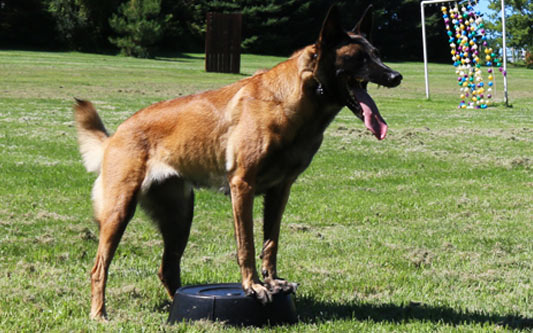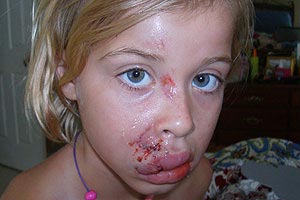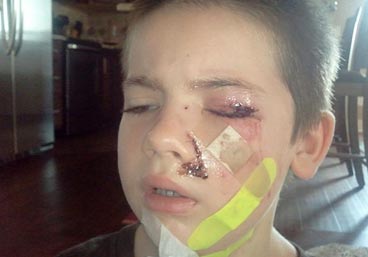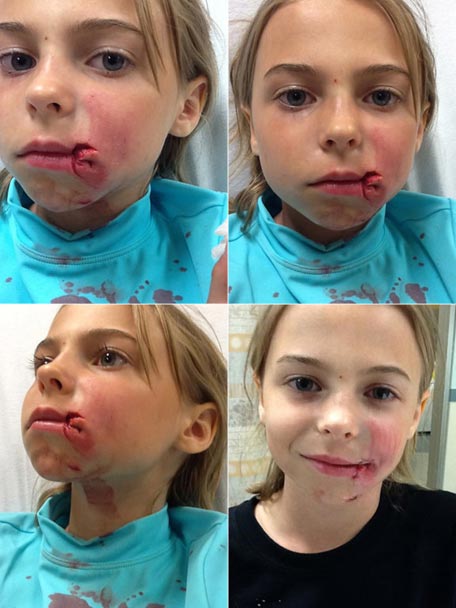WARNING: Graphic photos of dog bites below!

I have been involved in biting dog sports since 1974. I was a police K9 handler for 10 years and have been producing training videos on biting dogs since 1982.
The pictures in this article are the reason I feel that 99% of the people who think they should own a trained personal protection dog should never own one.

I know that there are so-called “Professional Dog Trainers” who offer protection dogs or for a fee will claim to protection train a clients dog. I am going to have to agree to disagree with these people.
I decided to write this article because of the many emails I get like the one below.
I have a 4-year-old Corso-Pit mix that has been obedience trained and I have been paying what, according to several individuals and his website, is a reputable trainer for bite and protection.
Today, my son took him for a walk and another guy who claims to be a trainer told my son my dog would not bite his sleeve and backed him up almost to the point of running. He was able to walk right up to my son and shake his hand.
This shouldnt have happened! Do you have any clue? It makes me afraid he wont protect me when walking him or if someone enters my home. And, no, the trainer never handles him, he instructs me or my son and we handle the dog.
The man who wrote this email does not understand how to evaluate his own dogs temperament and/or training.
One of two things will happen with someone like this:
It is unrealistic to expect a dog to determine when and who he can or cannot bite. It is also unrealistic to expect a child or even a young adult to be mature enough to command a dog to bite another person.
The real problem is that people just dont understand dogs, their character, temperament, and/or protection dog training.
Protection dog owners must also understand the liability they assume when they buy a trained dog. The likelihood of accidental bites are high. When that happens, the dogs owner is going to get sued. Home owners insurance will cover the first bite, but they will also cancel insurance policies. If the owner keeps that dog, he is not going to find another company willing to insure his home.
I created a dog bite article where we display photos people send me of dog bites. The majority of these bites are photos of dogs biting family members. The majority of the bites occurred when people tried to break up a dog fight, or when their family dog bit another member of the family. A warning, some of the photos on this page are graphic.
Accidents like these happen when people dont properly manage their dogs. The dogs have been allowed too much unsupervised freedom, or they are off-leash when they should not be.
The fact is a dog trained to protect should never be off-leash unless in a secure area. Protection dogs should never be sent off-leash to apprehend someone. Thats the job of a police service dog, not a personal protection dog. Thats why a protection dog should always remain on-leash and with the handler.

There are a number of dog sports that train dogs to bite people: Schutzhund, IPO, Mondio Ring, French Ring, Belgium Ring, the Dutch KNPV, etc.
People new to bite training often mistakenly believe that dogs trained in these sports will naturally protect their owner in a real-life encounter.
Most often, nothing could be further from the truth. There is a dramatic difference between a dog learning to bite a decoy wearing a bite sleeve or a body bite suit while on the training field and a dog learning to bite an intruder in your own home.
Most sport dogs are trained in prey drive. When a dog chases a rabbit or a ball, it does so in prey drive. When a dog plays tug with a rag or tug toy, it does so in prey drive. When that tug toy is then changed from the tug to a protective bite arm, the dog is still biting in prey drive.
Or if the tug is substituted for a leg sleeve and later for a body bite suit, it is still biting in prey drive. The sleeve or suit have just become big prey items to these dogs.
Take the bite sleeve or body bite suit away and the dog is not going to bite a person that was previously wearing the sleeve or suit, much less bite a complete stranger in a non-training environment.
I learned this little lesson over 40 years ago. I attended my first Schutzhund seminar in 1974 in St. Louis. The instructor was an old German man named Gernot Riddell. There were a couple of cocky guys with Dobermans who were outspoken about how tough their Dobermans were. Note: Protection drives have pretty much been bred out of the Doberman breed.
Gernot only took so much of these two and told them their dogs were anything but tough. He volunteered me to prove it and gave me a thin bamboo stick and told me to go to the other end of the football field.
He told me these guys were going to send both dogs after me once I got down there. Now I didnt have any protective equipment other than this skinny little stick.
Gernot told me to charge at the dogs screaming like the devil and waving the stick when I saw them coming. He also winked and said I didnt have anything to worry about. I wasnt so sure.
Do you know how loud you can scream when “YOURE NOT SO SURE” and two Dobermans are charging down the field to bite you? Well, its LOUD!
No one was more amazed (and happy) to see these two Dobes turn and run from me. These dogs had been trained in prey drive. They were not protection dogs. The majority of dogs in the protection dog sports will not bite a human that does not have a sleeve or bite suit on.
While these two dogs may not have bitten me on that field, they very easily could have bitten a child in their home who got too close to their food (while they were eating) or a child that tried to take a toy away from them or a child that jumped on them while they were sleeping.
My point here is that there are unscrupulous dog dealers selling dogs that come from these various protection dog sports. They put a sleeve on their decoy and then show their prospective client how tough that dog is. When in fact, the dog is a sport dog and not a personal protection dog.
When people do ask me what I think about getting a protection dog, I tell them to go out and find a nice dog. If they are genuinely concerned for their safety, they should get a nice large dog and learn how to manage the dog in their home. We have an free online course on how to manage your dog in addition learn how to obedience train it.
Teach the dog to bark on command and teach it to bark at the door when you tell it to. You can even teach him to bark when they hear the doorbell.
Very few criminals are going to come into a home with a barking dog. And very few will rob or kidnap someone that is walking a large dog. If they do, the owner needs to shoot them.
What the owner can do is teach their dog to wear a muzzle. Dogs wearing a muzzle send a message to people. Reaching down and sliding the muzzle off the dogs head sends a message to a bad guy.
We sell many styles of muzzles. I like the wire basket muzzle because the dog can easily drink with it on. We also have an online course on how to condition the dog to the muzzle.
In the end, I need to say that it takes a special dog to become a personal protection dog. These dogs are self-confident and strong dogs. They need a lot of training and the owner needs to 100% understand the training, handling, and management of these dogs.
If you want to learn how to do this correctly, buy a well-bred working dog and get involved in one of the working dog sports. Learning sport dog training is rewarding and a great hobby. Some sport dogs can be retrained into personal protection dogs, just like some sport dogs can be retrained to become police service dogs.
Be very careful who you listen to. You dont want your dog to cause something like the pictures below.

You could put your pet in harm’s way
While some intruders will flee at the first bark, others won’t be deterred by a home guard dog. Unfortunately, intruders sometimes resort to violence to silence dogs or protect themselves from an attack. If your dog is part of your family, you don’t want to put them at risk.
Once the puppies are born, they begin training at just eight weeks old; it will last for thousands of hours and more than two years. Svalinn’s program is intended to hone both their mental and physical faculties, though it’s the psychological training which truly sets these guard dogs apart. Greene and her team focus on finessing a dog’s ability to discern intent from other humans—for example, by using their ability to read biological rhythms and hormone spikes that might be associated with anger, long before any violence occurs. Of course, these dogs can also attack, if needed, but their prime mission is to help avert and avoid dangers, before they happen. “Aggression is the least important part. You can train any dog in the universe to bite, if necessary, but that is not the appeal of what we do,” she explains, likening her dogs to a special forces operator. “You know the guy—he’s lovable, and volunteering at church, and has perfect manners, but he also has a very deeply ingrained skillset.”
Each Svalinn dog is hand-delivered to clients, so Greene and her team of a dozen or so trainers can spend several days teaching them how to work with it—she likens owning a Svalinn shepherd to learning a new operating system on a computer compared with a conventional canine. Buyers must also commit to annual refresher courses to keep their handling skills primed. There’s no typical owner, either: her dogs live everywhere from the 37th floor of a high rise in the heart of a city to a houseboat. “At the end of the day, technology can fail, but our four-legged security goes with you everywhere—it can sleep in your daughter’s room at night, or travel on your jet with you,” she says. And what about sleeping on the bed? “In my house, there are no dogs on the bed,” she laughs, “But I’d tell you that about 50 percent of our owners end up doing that. Our dogs are stable, social and loving, and they want to be with their family all the time.”
Its name is a nod to Norse mythology, where Svalinn was a protective shield, and she stresses that these pups aren’t primed to be a personal Cujo. Instead Svalinn’s focus is on anticipation rather than aggression. Firstly, she breeds the dogs for their temperament, crossing German, Dutch and Belgian shepherds: the German bloodline primes them to be good family pets, while the Belgian confers a work ethic and high tenacity, and the Dutch a little of everything. “We want to ensure the health of the dog long term—purebreds do not hold up in nature, and we’re not trying to get into the Kennel Club,” she says, “Those three lines in general are all highly workable, protective and eager to please their owner.”
It was while living in Kenya with her then-husband that she first stumbled on protection dogs—a common option in the East African capital, and the couple bought one to help guard the family home. She preferred the peace of mind conferred by a dog over a handgun or a security system. “It works when the power goes off, or when there’s no water,” Greene tells Robb Report, “And unlike a firearm, it can’t be used against you.” Greene quickly realized there could be a market Stateside for elite guard dogs like these—and Svalinn was born.
Don’t think of one of Kim Greene’s $125,000 dogs as a pet, though they’re ideal for young families. The shepherd mixes she breeds on a 167-acre ranch in Livingston, Montana are more like personal bodyguards you can keep on call, and on duty, 24/7. Greene’s company, Svalinn, specializes in providing personal protection with a twist (and a tail).